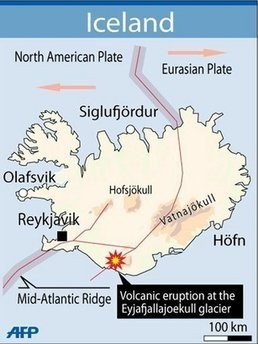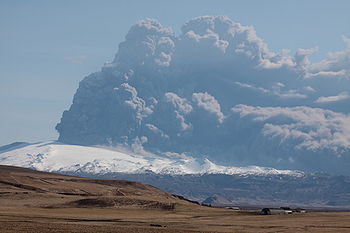Eyjafjallajökull :Volcanic ash cloud 2010
The iceland volcanic ash cloud caused by the eruption of Eyjafjallajökull in 2010 and 2011 caused significant disruption to Northern European air travel. Europe was baffled as to how a volcano in Icealand could cause so much trouble.

Iceland sits astride the Mid Atlantic ridge and is owes its entire existence to volcanic activity. Ihe country lies astride the boundary of two tectonic plates which are pulling away from each other. As the they move apart pressure on the magma mantle below is released and magma rises to the surface. This process usually happens unseen under the oceans waves but in Iceland another process is happenng too. A mantle plume or hot spot- a jet of hot mantle is brising rapidly towards the surface and produces vast quantities of lava which allows Iceland to break through the waves and form an island.

The eruption in the main central zone of volcanic activity where the crust is being pulled apart.
On March 20 2010 the eruption began after earthquake swarms indicated the magma chamber below the volcano was being filled with magma. The original eruption fissure was 500m long and erupted basalt lava out of 12 smaller volcanic centres. The fountains of liquid lava were at 1000 c. A new fissure opened on 31 March to the NW and was 300m long. At this point the eruption was explosive but effusive the key ingredient missing was water and volcanologists feared that the eruption may extend under the glacier- they were right!
Second eruption
On 14 April the eruption moved under the centre of the Eyjafjallajökull glacier (Jokull is lcelandic for glacier and Eyjafjalla is the name of the volcano.)The eruption began to melt the glacier and dramatic floodwaters gushed from the glacier and swept away the main coast road. Thde glacial water instantly cooled the erupting lava causing it to shatter into minute shards of glass and ash which were propelled 1000s metres into the atmosphere by the force of the explosions. This cloud drifted towards Northern Europe and closed the air space for days on end stranding millions of people all over the world who could not fly.
Scientists are watching the neighbouring volcano of Kafla which usually erupts in tandem with "EJ" it is considerably bigger so lets hope it stays sleeping.







